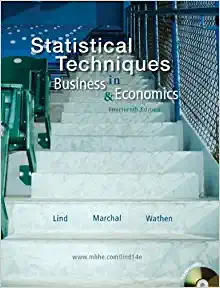Question
Question 1 (1 point) Total revenue is Question 1 options: a) the difference between the money brought into the firm from the sale of its
Question 1 (1 point)
Total revenue is
Question 1 options:
a)
the difference between the money brought into the firm from the sale of its goods and the cost of producing and selling the goods.
b)
the money brought into the firm from the sale of its goods.
c)
the cost of producing and selling the goods.
Question 2 (1 point)
Economic profit is the difference between
Question 2 options:
a)
how much the firm spends and how much it predicted it would spend.
b)
the value of resources the firm uses and how much it predicted the value would be.
c)
the firm's revenue and the value of resources it uses.
d)
the firm's revenue and how much the firm spends.
Question 3 (1 point)
Costs exists even when the firm produces zero units are
Question 3 options:
a)
implicit costs.
b)
variable costs.
c)
explicit costs.
d)
fixed costs.
Question 4 (1 point)
During the long run period of the production process, a firm will be
Question 4 options:
a)
able to vary some of its inputs.
b)
unable to vary any of its inputs.
c)
unable to vary the size of its plant.
d)
able to vary all of its inputs.
Question 5 (1 point)
Average variable cost, or AVC, equals
Question 5 options:
a)
ATC - (FC / Q)
b)
FC / TC
c)
AVC / Q
d)
VC * Q
Question 6 (1 point)
The law of diminishing returns states that, as a firm uses more of a ______ input with a given quantity of a ______ input, the ______ return on the ______ input eventually gets smaller.
Question 6 options:
a)
fixed; variable; marginal; fixed
b)
fixed; variable; total; fixed
c)
variable; fixed; average; variable
d)
variable; fixed; marginal; variable
Question 7 (1 point)
______ are features of a firm's technology that lead to rising long-run average cost as output increases.
Question 7 options:
a)
Diseconomies of scale
b)
Economies of scale
c)
Diminishing returns
d)
Output economies
Question 8 (1 point)
A normal rate of profit is
Question 8 options:
a)
zero economic profit.
b)
an accounting rate of return of 3%.
c)
an economic rate of return of 3%.
d)
zero accounting profit.
Question 9 (1 point)
A barrier to entry
Question 9 options:
a)
All of these are true.
b)
is anything that makes it difficult for a new company to make a profit.
c)
can be a monopoly.
d)
may be large variable costs.
Question 10 (1 point)
Which is a characteristic of a perfectly competitive market?
Question 10 options:
a)
There are many firms which each produce a small portion of the total quantity.
b)
All of these.
c)
It is difficult for new firms to enter the market.
d)
Firms produce differentiated products.
Question 11 (1 point)
If a firm produces the quantity at which MR = MC, then
Question 11 options:
a)
the firm is maximizing revenue.
b)
consumers are receiving no consumer surplus.
c)
the firm is maximizing profit.
d)
producers are receiving no producer surplus.
Question 12 (1 point)
If marginal cost exceeds marginal revenue, a profit maximizing firm should
Question 12 options:
a)
should expand output.
b)
is making a positive profit.
c)
should reduce output.
d)
is making a negative profit.
Question 13 (1 point)
A firm operating in a perfectly competitive market
Question 13 options:
a)
can increase the number of units that it sells by charging a lower price.
b)
has a firm specific demand curve that is perfectly inelastic.
c)
can change output levels without having any significant effect on price.
d)
should try to increase price through advertising.
Question 14 (1 point)
Tommy's Tomato Farm operates in a perfectly competitive market. If other tomato producers charge $2/pound for tomatoes, which is TRUE?
Question 14 options:
a)
Tommy must charge $2/pound.
b)
All of these.
c)
Tommy's marginal revenue is $2/pound.
d)
Demand for Tommy's Tomatoes is perfectly elastic and equal to $2/pound.
Question 15 (1 point)
Which is true for a firm operating in a perfectly competitive market?
Question 15 options:
a)
Q is found where MR = MC
b)
All of these.
c)
profit = (P - AVC)*Q
d)
the firm should shut down in the short run if P < ATC
Question 16 (1 point)
A sunk cost is irrelevant to a firm's current decisions because
Question 16 options:
a)
it occurred in the long run.
b)
it cannot be changed by any current decision.
c)
it is a variable factor of production.
d)
the decision to make the expenditure was made by previous managers.
Question 17 (1 point)
If firms in a competitive market are making a negative economic profit, then there is
Question 17 options:
a)
no incentive for firms to either enter or exit the market.
b)
an incentive for firms to exit the market.
c)
an incentive for firms to enter the market.
Question 18 (1 point)
If the market for Good X is perfectly competitive, in long run equilibrium, each firm is
a)
making economic profit.
b)
incurring an economic loss.
c)
making normal profit.
d)
just covering total variable cost.
Question 18 options:
Step by Step Solution
There are 3 Steps involved in it
Step: 1

Get Instant Access to Expert-Tailored Solutions
See step-by-step solutions with expert insights and AI powered tools for academic success
Step: 2

Step: 3

Ace Your Homework with AI
Get the answers you need in no time with our AI-driven, step-by-step assistance
Get Started


